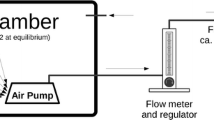Abstract
A passive diffusion method for the determination of radon concentration has been optimised and calibrated. The device consists of a scintillation vial containing activated charcoal, a diffusion barrier and a desiccant agent. The response to diverse atmospheric humidity and variable exposure intervals was studied. The result is a detector independent of atmospheric humidity till 7 days of exposure. The method was compared with electret detectors (US EPA) with very satisfactory results. The advantages of this method are its simplicity, low cost, low detection limit, the total automatization of the measurement and its total independence of humidity to measure in a wide range of radon concentrations.
Similar content being viewed by others
References
United Nations Scientific Committee on the Effects of Atomic Radiation, Sources and Effects of Ionizing Radiation, UNSCEAR Report to the General Assembly with Scientific Annexes, United Nations, New York, 1993, p. 45.
M. L. Maiello, N. H. Harley, Health Phys., 53 (1987) 301.
M. Urban, D. A. C. Binns, J. J. Estrada, KFK 3866, CNEN 1101, 1985.
P. Kotrappa, J. C. Dempsey, J. R. Hickey, L. R. Stieff, Health Phys., 54 (1988) 47.
B. L. Cohen, E. S. Cohen, Health Phys., 45 (1983) 501.
A. C. George, Health Phys., 46 (1984) 867.
H. M. Prichard, K. A. Marien, Health Phys., 48 (1985) 797.
B. L. Cohen, R. Nason Health Phys., 50 (1986) 457.
T. Ren, L. Lin, Rad. Prot. Dosim., 19 (1987) 121.
U.S. Environmental Protection Agency, NAREL Standard Operating Procedures for Radon-222, Measurement Using Diffusion Barrier Charcoal Canister, Washington D.C., U.S. EPA Office of Radiation Programme, EPA 520/5-90-032, 1990.
C. S. Scarpitta, Health Phys., 62 (1992) 576.
M. C. Schroeder, U. Vanags, C. T. Hess, Health Phys., 57 (1989) 43.
F. Schönhofer, K. Pock, H. Friedmann J. Radioanal. Nucl. Chem., 193 (1995) 337.
H. M. Prichard, K. Marien, Anal. Chem., 55 (1983) 155.
P. M. Pojer, J. Peggie, R. O'Brien, S. Solomon, K. Wise, Health Phys., 58 (1990) 13.
C. S. Scarpitta, Health Phys., 68 (1995) 332.
H. L. Lucas Rev. Sci. Instrum., 28 (1957) 680.
C. J. Passo, G. T. Cook, Handbook of Environmental Liquid Scintillation Spectrometry, Packard Instrument Company, 1994, p. 8.
Author information
Authors and Affiliations
Rights and permissions
About this article
Cite this article
Canoba, A.C., López, F.O. & Oliveira, A.A. Radon determination by activated charcoal adsorption and liquid scintillation measurement. J Radioanal Nucl Chem 240, 237–241 (1999). https://doi.org/10.1007/BF02349160
Received:
Issue Date:
DOI: https://doi.org/10.1007/BF02349160




